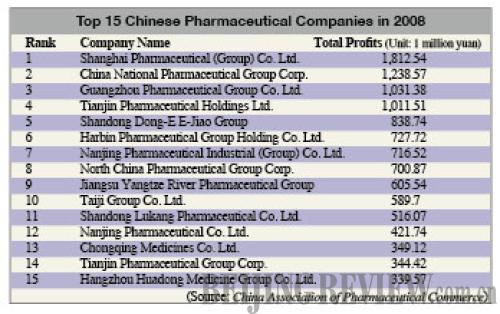|
Global competition
Substantial reform of China's healthcare system will be carried out later this year. Since all basic medicines will be covered by medical insurance reimbursement, producers will face fierce competition among them. Currently, China has more than 4,700 pharmaceutical companies, most of which are involved in the production of basic medicines.
The Guosen Securities report said healthcare reform is a systematic and long-term project, and will inevitably change the competitive behaviors and structure of pharmaceutical companies and medicine traders. It will also optimize the competition order of the whole industrial chain of pharmaceutical and healthcare industries.
But more significant competition may come from the international market. A report from the Chamber of Commerce for Import and Export of Medicines and Health Products of China said at present, foreign investors are expanding in the medicine and healthcare fields.
In 2009, five major international pharmaceutical companies began expanding their markets in China. In the early months of 2009, Bayer Schering Pharma AG invested 100 million euros ($70 million) to establish a global research and development center in Beijing, making it its fourth largest research and development base; in March, Eli Lilly and Co. from the United States carried out a large-scale expansion at its Suzhou plant; in August, Novartis AG began to focus on the grass-roots healthcare market of China; in September, AstraZeneca, headquartered in Britain, established its China branch in Shanghai, researching and developing innovative medicines; in October, Boehringer Ingelheim from Germany announced to expand its investment in China by 100 million euros to develop its production capacity and establish a research and development center in the country; France-based Sanofi-aventis has so far invested 1.3 billion yuan ($190.37 million) in China, breaking a record of investment by transnational pharmaceutical companies in the country; and Sandoz, the world's second-largest producer of generic medicines, also said in 2009 it would race to seize the Chinese market in the generics field.
According to statistics released by the Ministry of Commerce, 223 foreign-invested companies involved in pharmaceutical and healthcare industries were approved in 2009, a year-on-year decline of 15.21 percent. However, the paid-in capital surged 33.66 percent, hitting $1.11 billion. At present, joint ventures and exclusively foreign-owned companies account for 30 percent of the total number of Chinese pharmaceutical companies, while their sales volume makes up 27 percent of the total of medical products in the country.
According to the China Association of Pharmaceutical Commerce, the output value of China's medical industry in 2009 totaled 940.3 billion yuan ($137.67 billion), growing 21 percent year on year—higher than the average industrial growth of the rest of the country in the same period. The industry's overall economic returns have been markedly improved, and the Chinese medical market has become a platform seized by companies both from home and abroad.
Another goal of China's healthcare system reform is to strengthen domestic pharmaceutical companies to allow them to compete with international pharmaceutical businesses, and Shanghai has listed the pharmaceutical industry as one of the pillar industries to its economic development. An enormous amount of pressure has been placed on the pharmaceutical industry in Shanghai to reach this goal—hence, to expand through reorganization has become one of the ways to further its development.

| 